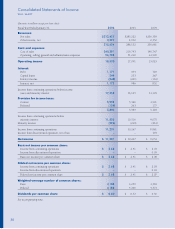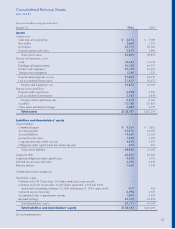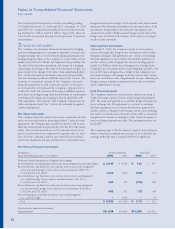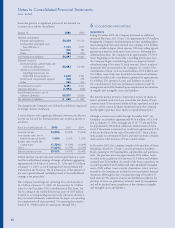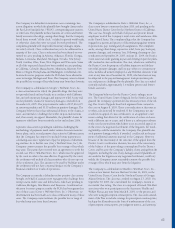Walmart 2006 Annual Report Download - page 37
Download and view the complete annual report
Please find page 37 of the 2006 Walmart annual report below. You can navigate through the pages in the report by either clicking on the pages listed below, or by using the keyword search tool below to find specific information within the annual report.
35
Goodwill is recorded on the balance sheet in the operating seg-
ments as follows (in millions):
January 31, 2006 2005
International $11,883 $10,498
SAM’S CLUB 305 305
Total goodwill $12,188 $10,803
The fi scal 2006 consolidation of The Seiyu, Ltd. and acquisition
of Sonae Distribuição Brasil S.A. and the fi scal 2005 acquisition of
Bompreço S.A. Supermercados do Nordeste resulted in increases
to goodwill. In addition, changes in the International segment’s
goodwill result from foreign currency exchange rate fl uctuations.
Leases
The Company estimates the expected term of a lease by assuming
the exercise of renewal options where an economic penalty exists
that would preclude the abandonment of the lease at the end of
the initial non-cancelable term and the exercise of such renewal is
at the sole discretion of the Company. This expected term is used
in the determination of whether a store lease is a capital or oper-
ating lease and in the calculation of straight-line rent expense.
Additionally, the useful life of leasehold improvements is limited
by the expected lease term. If signifi cant expenditures are made for
leasehold improvements late in the expected term of a lease, judg-
ment is applied to determine if the leasehold improvements have a
useful life that extends beyond the original expected lease term or
if the leasehold improvements have a useful life that is bound by
the end of the original expected lease term.
Rent abatements and escalations are considered in the calculation
of minimum lease payments in the Company’s capital lease tests
and in determining straight-line rent expense for operating leases.
Foreign Currency Translation
The assets and liabilities of all foreign subsidiaries are translated
using exchange rates at the balance sheet date. The income state-
ments of foreign subsidiaries are translated using average exchange
rates. Related translation adjustments are recorded as a compo-
nent of accumulated other comprehensive income.
Revenue Recognition
The Company recognizes sales revenue net of estimated sales
returns at the time it sells merchandise to the customer, except
for layaway transactions. The Company recognizes revenue from
layaway transactions when the customer satisfi es all payment
obligations and takes possession of the merchandise. Customer
purchases of Wal-Mart and SAM’S CLUB shopping cards are not
recognized as revenue until the card is redeemed and the cus-
tomer purchases merchandise by using the shopping card.
SAM’S CLUB Membership Fee Revenue Recognition
The Company recognizes SAM’S CLUB membership fee revenues
both in the United States and internationally over the term of the
membership, which is 12 months. The following table details
unearned revenues, membership fees received from members and
the amount of revenues recognized in earnings for each of the fi s-
cal years 2006, 2005 and 2004 (in millions):
Fiscal Year Ended January 31, 2006 2005 2004
Deferred membership fee revenue,
beginning of year $ 458 $ 449 $ 437
Membership fees received 940 890 840
Membership fee revenue recognized (908) (881) (828)
Deferred membership fee revenue,
end of year $ 490 $ 458 $ 449
SAM’S CLUB membership revenue is included in other income, net
in the revenues section of the Consolidated Statements of Income.
The Company’s deferred membership fee revenue is included
in accrued liabilities in the Consolidated Balance Sheets. The
Company’s analysis of historical membership fee refunds indicates
that such refunds have been nominal. Accordingly, no reserve
existed for membership fee refunds at January 31, 2006 and 2005.
Cost of Sales
Cost of sales includes actual product cost, change in inventory,
the cost of transportation to the Company’s warehouses from
suppliers, the cost of transportation from the Company’s ware-
houses to the stores and clubs and the cost of warehousing for
our SAM’S CLUB segment.
Payments from Suppliers
Wal-Mart receives money from suppliers for various programs, pri-
marily volume incentives, warehouse allowances and reimburse-
ments for specifi c programs such as markdowns, margin protection
and advertising. Substantially all allowances are accounted for
as a reduction of purchases and recognized in our Consolidated
Statements of Income when the related inventory is sold.
Operating, Selling, General and Administrative Expenses
Operating, selling, general and administrative expenses include all
operating costs of the Company that are not related to the transpor-
tation of products from the supplier to the warehouse or from the
warehouse to the store. Additionally, the cost of warehousing and
occupancy for our Wal-Mart Stores segment distribution facilities are
included in operating, selling, general and administrative expenses.
Because we do not include the cost of our Wal-Mart Stores seg-
ment distribution facilities in cost of sales, our gross profi t and gross
margin may not be comparable to those of other retailers that may
include all costs related to their distribution facilities in costs of sales
and in the calculation of gross profi t and gross margin.







